2013 NISSAN SENTRA tires
[x] Cancel search: tiresPage 344 of 372

9 Technical and consumer information
Capacities and recommended fuel/lubricants.........9-2
Fuel recommendation ...........................9-3
Engine oil and oil filter recommendations ..........9-5
Air conditioner system refrigerant and oil
recommendations ..............................9-6
Specifications .....................................9-7
Engine ........................................9-7
Wheels and tires ...............................9-8
Dimensions and weights ........................9-8
When traveling or registering your vehicle in
another country ...................................9-9
Vehicle identification ...............................9-9
Vehicle identification number (VIN) plate ..........9-9
Vehicle identification number
(chassis number) ...............................9-9
Engine serial number ........................... 9-10
F.M.V.S.S./C.M.V.S.S. certification label ..........9-10 Emission control information label
...............9-10
Tire and loading information label ................9-11
Air conditioner specification label ................9-11
Installing front license plate ........................9-11
Vehicle loading information ........................9-12
Terms ........................................ 9-12
Vehicle load capacity .......................... 9-13
Loading tips . . . ............................... 9-15
Measurement of weights .......................9-15
Towing a trailer ................................... 9-16
Flat towing .................................... 9-16
Uniform tire quality grading ........................9-16
Emission control system warranty ..................9-17
Reporting safety defects .......................... 9-18
Readiness for inspection/maintenance (I/M) test .....9-19
Event Data Recorders (EDR) .......................9-19
Owner’s Manual/Service Manual order information . . . 9-20
Page 351 of 372
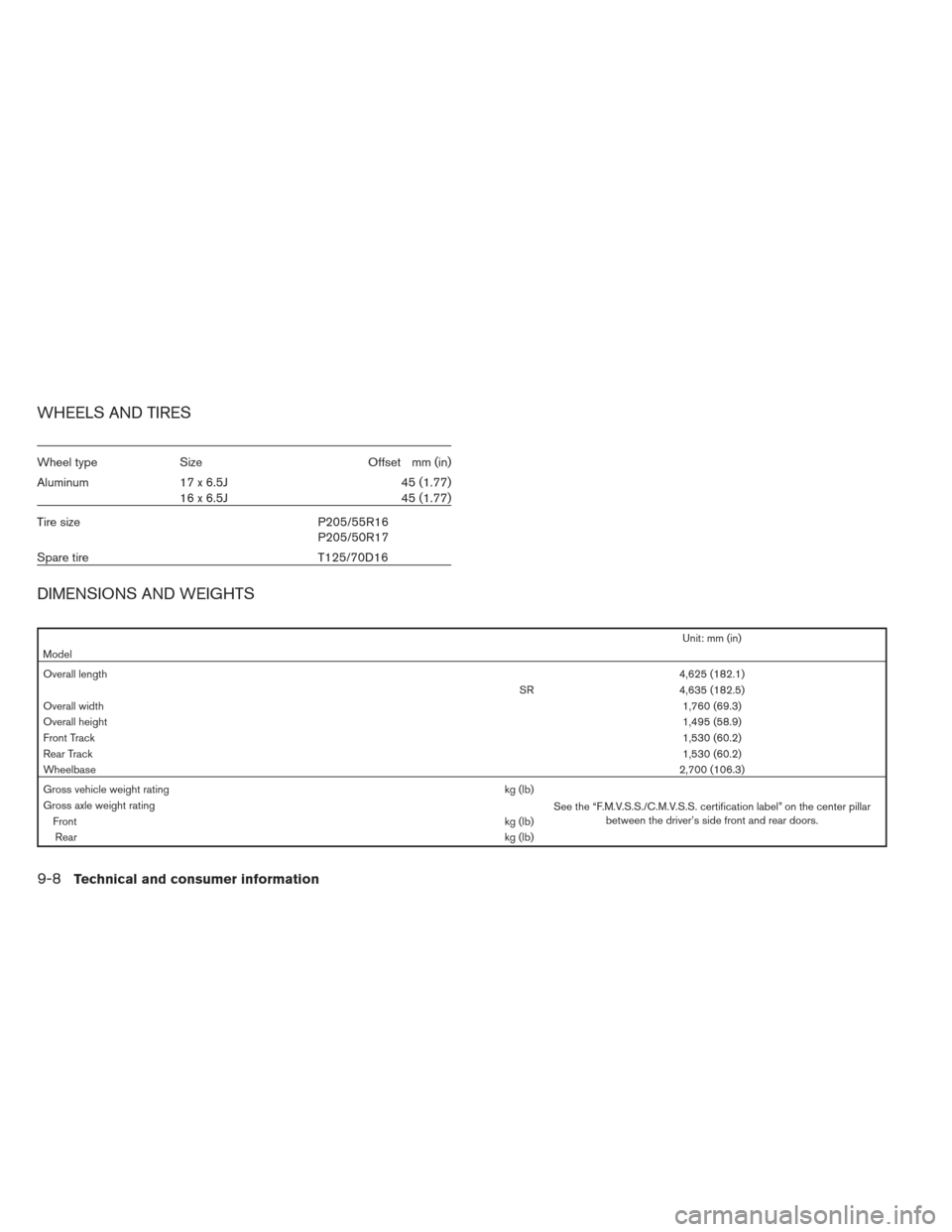
WHEELS AND TIRES
Wheel typeSize Offset mm (in)
Aluminum 17 x 6.5J
16x6.5J 45 (1.77)
45 (1.77)
Tire size P205/55R16
P205/50R17
Spare tire T125/70D16
DIMENSIONS AND WEIGHTS
Unit: mm (in)
Model
Overall length 4,625 (182.1)
SR 4,635 (182.5)
Overall width 1,760 (69.3)
Overall height 1,495 (58.9)
Front Track 1,530 (60.2)
Rear Track 1,530 (60.2)
Wheelbase 2,700 (106.3)
Gross vehicle weight rating kg (lb)
See the “F.M.V.S.S./C.M.V.S.S. certification label” on the center pillar between the driver’s side front and rear doors.
Gross axle weight rating
Front kg (lb)
Rear kg (lb)
9-8Technical and consumer information
Page 358 of 372
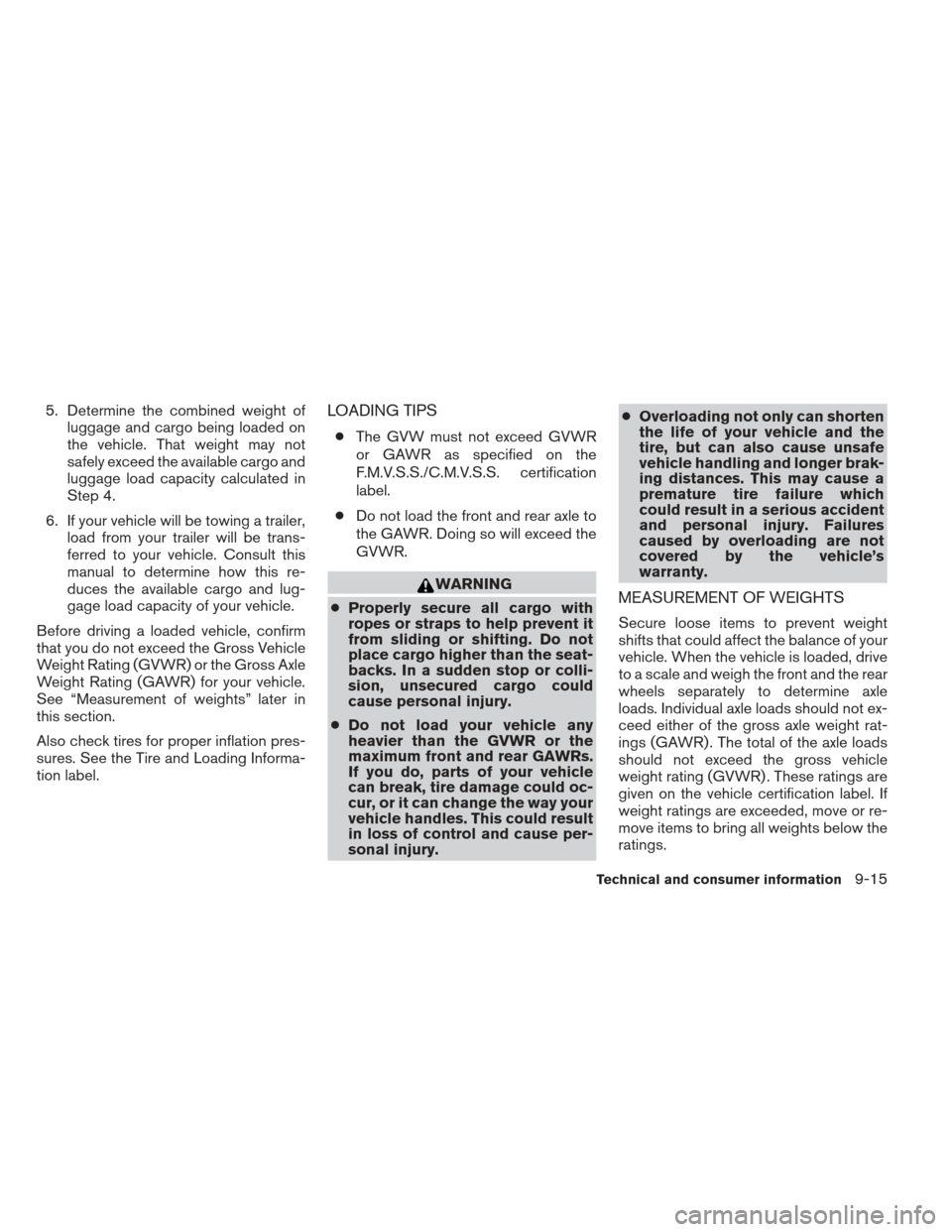
5. Determine the combined weight ofluggage and cargo being loaded on
the vehicle. That weight may not
safely exceed the available cargo and
luggage load capacity calculated in
Step 4.
6. If your vehicle will be towing a trailer, load from your trailer will be trans-
ferred to your vehicle. Consult this
manual to determine how this re-
duces the available cargo and lug-
gage load capacity of your vehicle.
Before driving a loaded vehicle, confirm
that you do not exceed the Gross Vehicle
Weight Rating (GVWR) or the Gross Axle
Weight Rating (GAWR) for your vehicle.
See “Measurement of weights” later in
this section.
Also check tires for proper inflation pres-
sures. See the Tire and Loading Informa-
tion label.LOADING TIPS
● The GVW must not exceed GVWR
or GAWR as specified on the
F.M.V.S.S./C.M.V.S.S. certification
label.
● Do not load the front and rear axle to
the GAWR. Doing so will exceed the
GVWR.
WARNING
● Properly secure all cargo with
ropes or straps to help prevent it
from sliding or shifting. Do not
place cargo higher than the seat-
backs. In a sudden stop or colli-
sion, unsecured cargo could
cause personal injury.
● Do not load your vehicle any
heavier than the GVWR or the
maximum front and rear GAWRs.
If you do, parts of your vehicle
can break, tire damage could oc-
cur, or it can change the way your
vehicle handles. This could result
in loss of control and cause per-
sonal injury. ●
Overloading not only can shorten
the life of your vehicle and the
tire, but can also cause unsafe
vehicle handling and longer brak-
ing distances. This may cause a
premature tire failure which
could result in a serious accident
and personal injury. Failures
caused by overloading are not
covered by the vehicle’s
warranty.MEASUREMENT OF WEIGHTS
Secure loose items to prevent weight
shifts that could affect the balance of your
vehicle. When the vehicle is loaded, drive
to a scale and weigh the front and the rear
wheels separately to determine axle
loads. Individual axle loads should not ex-
ceed either of the gross axle weight rat-
ings (GAWR) . The total of the axle loads
should not exceed the gross vehicle
weight rating (GVWR) . These ratings are
given on the vehicle certification label. If
weight ratings are exceeded, move or re-
move items to bring all weights below the
ratings.
Technical and consumer information9-15
Page 359 of 372

Do not tow a trailer with your vehicle.
FLAT TOWING
Towing your vehicle with all four wheels on the
ground is sometimes called flat towing. This
method is sometimes used when towing a vehicle
behind a recreational vehicle, such as a motor
home.
CAUTION
●Failure to follow these guidelines can
result in severe transmission damage.
● Whenever flat towing your vehicle, al-
ways tow forward, never backward.
● DO NOT tow any continuously variable
transmission vehicle with all four
wheels on the ground (flat towing) . Do-
ing so WILL DAMAGE internal transmis-
sion parts due to lack of transmission
lubrication.
● For emergency towing procedures refer
to “Towing recommended by NISSAN”
in the “In case of emergency” section of
this manual.
Manual Transmission (if so equipped)
● Always tow with the manual transmission in
Neutral.
● After towing 500 miles (805 km) , start and
idle the engine with the transmission in Neu-
tral for two minutes. Failure to idle the engine
after every 500 miles (805 km) of towing
may cause damage to internal transmission
parts.
Continuously Variable Transmission (if
so equipped)
To tow a vehicle equipped with a continuously
variable transmission, an appropriate vehicle
dolly MUST be placed under the towed vehicle’s
drive wheels. Alwaysfollow the dolly manufac-
turer’s recommendations when using their prod-
uct. DOT (Department of Transportation) Quality
Grades: All passenger car tires must conform to
federal safety requirements in addition to these
grades.
Quality grades can be found where applicable on
the tire sidewall between tread shoulder and
maximum section width. For example:
Treadwear 200 Traction AA Temperature A
Treadwear
The treadwear grade is a comparative rating
based on the wear rate of the tire when tested
under controlled conditions on a specified gov-
ernment test course. For example, a tire graded
150 would wear one and one-half (1 1/2) times
as well on the government course as a tire graded
100. The relative performance of tires depends
upon the actual conditions of their use, however,
and may depart significantly from the norm due to
variations in driving habits, service practices and
differences in road characteristics and climate.
Traction AA, A, B and C
The traction grades, from highest to lowest, are
AA, A, B, and C. Those grades represent the
tire’s ability to stop on wet pavement as mea-
sured under controlled conditions on specified
government test surfaces of asphalt and con-
crete. A tire marked C may have poor traction
performance.
TOWING A TRAILER
UNIFORM TIRE QUALITY GRADING
9-16Technical and consumer information
Page 360 of 372
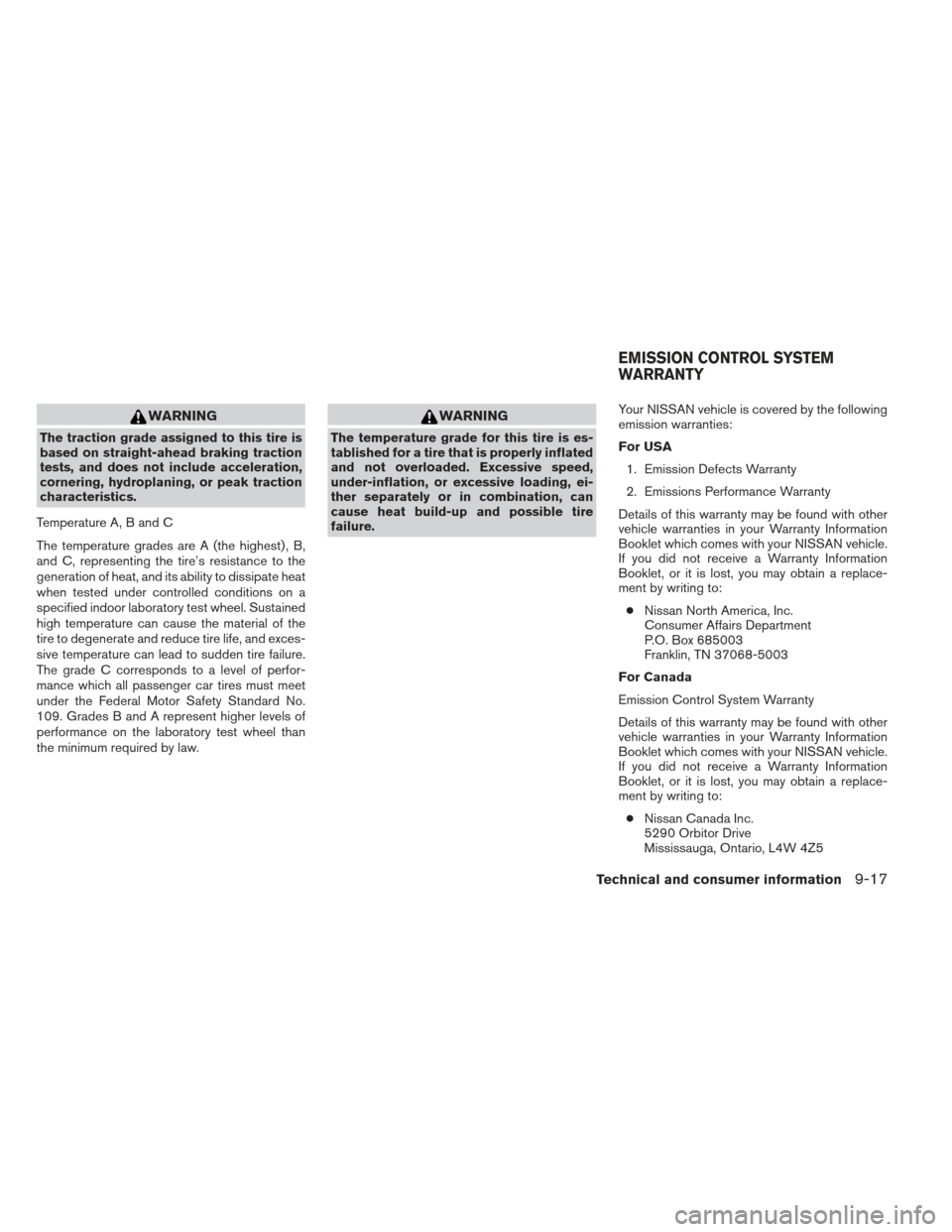
WARNING
The traction grade assigned to this tire is
based on straight-ahead braking traction
tests, and does not include acceleration,
cornering, hydroplaning, or peak traction
characteristics.
Temperature A, B and C
The temperature grades are A (the highest) , B,
and C, representing the tire’s resistance to the
generation of heat, and its ability to dissipate heat
when tested under controlled conditions on a
specified indoor laboratory test wheel. Sustained
high temperature can cause the material of the
tire to degenerate and reduce tire life, and exces-
sive temperature can lead to sudden tire failure.
The grade C corresponds to a level of perfor-
mance which all passenger car tires must meet
under the Federal Motor Safety Standard No.
109. Grades B and A represent higher levels of
performance on the laboratory test wheel than
the minimum required by law.
WARNING
The temperature grade for this tire is es-
tablished for a tire that is properly inflated
and not overloaded. Excessive speed,
under-inflation, or excessive loading, ei-
ther separately or in combination, can
cause heat build-up and possible tire
failure. Your NISSAN vehicle is covered by the following
emission warranties:
For USA
1. Emission Defects Warranty
2. Emissions Performance Warranty
Details of this warranty may be found with other
vehicle warranties in your Warranty Information
Booklet which comes with your NISSAN vehicle.
If you did not receive a Warranty Information
Booklet, or it is lost, you may obtain a replace-
ment by writing to: ● Nissan North America, Inc.
Consumer Affairs Department
P.O. Box 685003
Franklin, TN 37068-5003
For Canada
Emission Control System Warranty
Details of this warranty may be found with other
vehicle warranties in your Warranty Information
Booklet which comes with your NISSAN vehicle.
If you did not receive a Warranty Information
Booklet, or it is lost, you may obtain a replace-
ment by writing to: ● Nissan Canada Inc.
5290 Orbitor Drive
Mississauga, Ontario, L4W 4Z5
EMISSION CONTROL SYSTEM
WARRANTY
Technical and consumer information9-17
Page 369 of 372
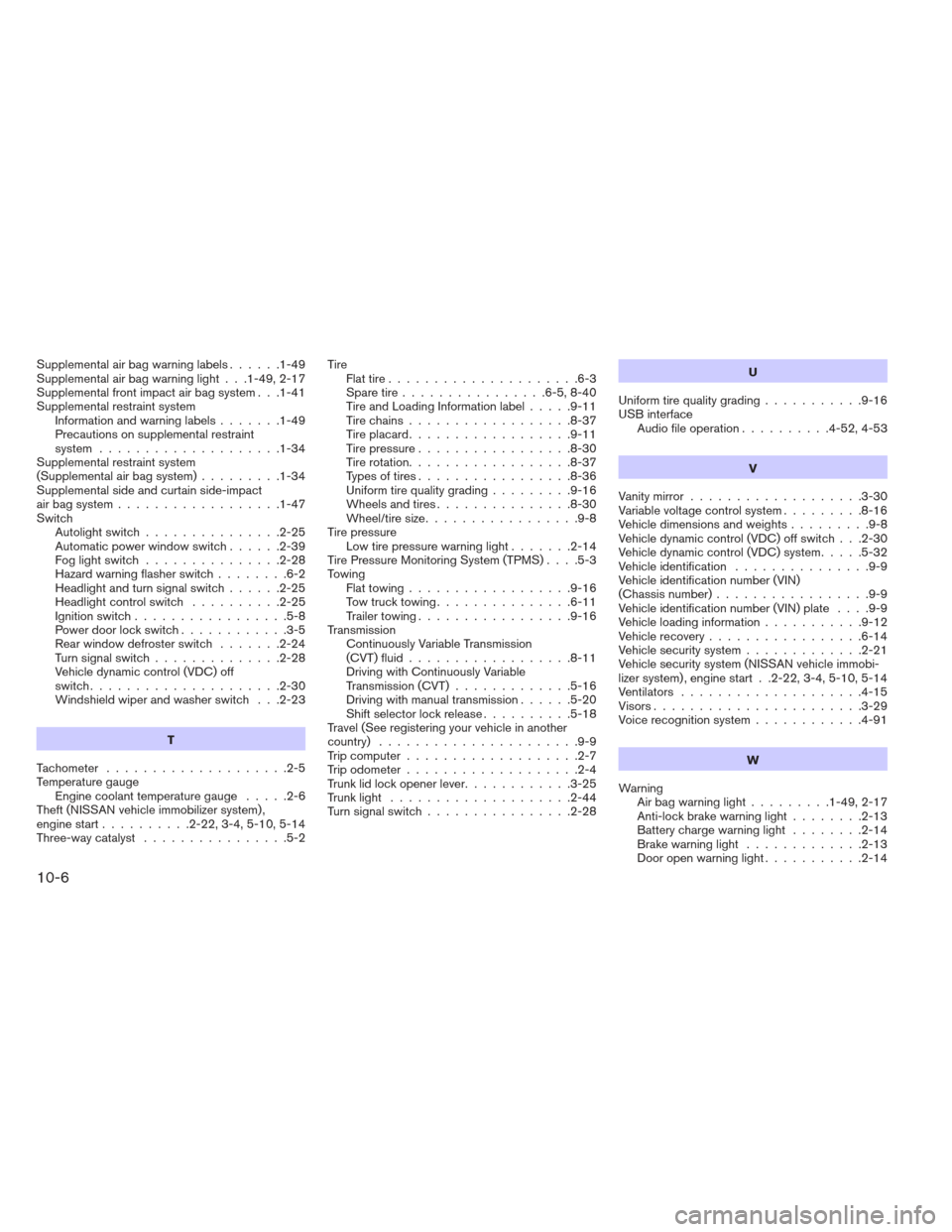
Supplemental air bag warning labels......1-49
Supplemental air bag warning light . . .1-49, 2-17
Supplemental front impact air bag system . . .1-41
Supplemental restraint system Information and warning labels .......1-49
Precautions on supplemental restraint
system ....................1-34
Supplemental restraint system
(Supplemental air bag system) .........1-34
Supplemental side and curtain side-impact
airbagsystem..................1-47
Switch Autolightswitch...............2-25
Automatic power window switch ......2-39
Foglightswitch ...............2-28
Hazard warning flasher switch ........6-2
Headlight and turn signal switch ......2-25
Headlightcontrolswitch ..........2-25
Ignition switch .................5-8
Power door lock switch ............3-5
Rear window defroster switch .......2-24
Turnsignalswitch..............2-28
Vehicle dynamic control (VDC) off
switch.....................2-30
Windshield wiper and washer switch . . .2-23
T
Tachometer ....................2-5
Temperature gauge Engine coolant temperature gauge .....2-6
Theft (NISSAN vehicle immobilizer system) ,
engine start ..........2-22,3-4,5-10,5-14
Three-way catalyst ................5-2 Tire
Flat tire .....................6-3
Spare tire ................6-5,8-40
Tire and Loading Information label .....9-11
Tirechains..................8-37
Tireplacard..................9-11
Tire pressure .................8-30
Tire rotation..................8-37
Types of tires .................8-36
Uniform tire quality grading .........9-16
Wheels and tires ...............8-30
Wheel/tire size .................9-8
Tire pressure Low tire pressure warning light .......2-14
Tire Pressure Monitoring System (TPMS) ....5-3
Towing Flattowing..................9-16
Towtrucktowing...............6-11
Trailer towing .................9-16
Transmission Continuously Variable Transmission
(CVT) fluid ..................8-11
Driving with Continuously Variable
Transmission (CVT) .............5-16
Driving with manual transmission ......5-20
Shiftselectorlockrelease..........5-18
Travel (See registering your vehicle in another
country) ......................9-9
Trip computer ...................2-7
Trip odometer ...................2-4
Trunk lid lock opener lever ............3-25
Trunklight ....................2-44
Turn signal switch ................2-28 U
Uniform tire quality grading ...........9-16
USB interface Audio file operation ..........4-52,4-53
V
Vanity mirror ...................3-30
Variable voltage control system .........8-16
Vehicledimensionsandweights.........9-8
Vehicle dynamic control (VDC) off switch . . .2-30
Vehicle dynamic control (VDC) system .....5-32
Vehicle identification ...............9-9
Vehicle identification number (VIN)
(Chassis number) .................9-9
Vehicle identification number (VIN) plate ....9-9
Vehicleloadinginformation...........9-12
Vehicle recovery .................6-14
Vehicle security system .............2-21
Vehicle security system (NISSAN vehicle immobi-
lizer system) , engine start . .2-22, 3-4, 5-10, 5-14
V
entilators ....................4-15
Visors.......................3-29
Voice recognition system ............4-91
W
Warning Airbagwarninglight.........1-49, 2-17
Anti-lock brake warning light ........2-13
Battery charge warning light ........2-14
Brake warning light .............2-13
Door open warning light ...........2-14
10-6
Page 370 of 372

Engine oil pressure warning light......2-14
Hazard warning flasher switch ........6-2
Lowfuelwarninglight............2-14
Low tire pressure warning light .......2-14
Low windshield-washer fluid warning
light......................2-16
Passenger air bag and status light .....1-43
Seat belt warning light ............2-17
Vehicle security system ...........2-21
Warning/indicator lights and audible
reminders ...................2-12
Warning labels (for SRS) ..........1-49
Warninglights..................2-12
Washer switch Windshield wiper and washer switch . . .2-23
Weights(Seedimensionsandweights).....9-8
Wheels and tires .................8-30
Wheel/tire size ...................9-8
When traveling or registering your vehicle
in another country .................9-9
Windows Locking passengers’ windows .......2-39
Power rear windows .............2-39
Power windows ...............2-37
Rear power windows ............2-39
Windshield-washer fluid .............8-12
Windshield wiper and washer switch .....2-23
Wiper Windshield wiper and washer switch . . .2-23
Wiper blades .................8-18
10-7
Page 371 of 372
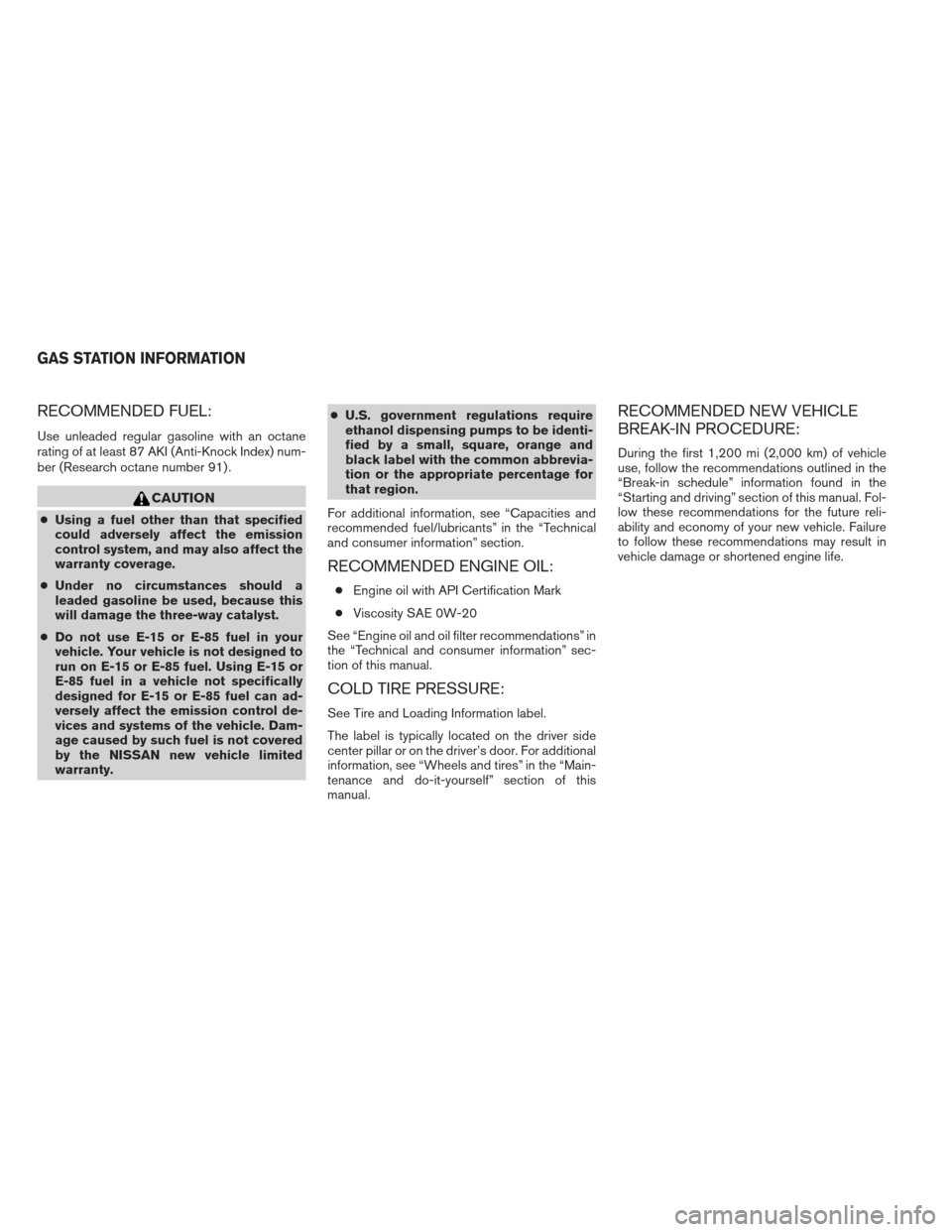
RECOMMENDED FUEL:
Use unleaded regular gasoline with an octane
rating of at least 87 AKI (Anti-Knock Index) num-
ber (Research octane number 91) .
CAUTION
●Using a fuel other than that specified
could adversely affect the emission
control system, and may also affect the
warranty coverage.
● Under no circumstances should a
leaded gasoline be used, because this
will damage the three-way catalyst.
● Do not use E-15 or E-85 fuel in your
vehicle. Your vehicle is not designed to
run on E-15 or E-85 fuel. Using E-15 or
E-85 fuel in a vehicle not specifically
designed for E-15 or E-85 fuel can ad-
versely affect the emission control de-
vices and systems of the vehicle. Dam-
age caused by such fuel is not covered
by the NISSAN new vehicle limited
warranty. ●
U.S. government regulations require
ethanol dispensing pumps to be identi-
fied by a small, square, orange and
black label with the common abbrevia-
tion or the appropriate percentage for
that region.
For additional information, see “Capacities and
recommended fuel/lubricants” in the “Technical
and consumer information” section.
RECOMMENDED ENGINE OIL:
● Engine oil with API Certification Mark
● Viscosity SAE 0W-20
See “Engine oil and oil filter recommendations” in
the “Technical and consumer information” sec-
tion of this manual.
COLD TIRE PRESSURE:
See Tire and Loading Information label.
The label is typically located on the driver side
center pillar or on the driver’s door. For additional
information, see “Wheels and tires” in the “Main-
tenance and do-it-yourself” section of this
manual.
RECOMMENDED NEW VEHICLE
BREAK-IN PROCEDURE:
During the first 1,200 mi (2,000 km) of vehicle
use, follow the recommendations outlined in the
“Break-in schedule” information found in the
“Starting and driving” section of this manual. Fol-
low these recommendations for the future reli-
ability and economy of your new vehicle. Failure
to follow these recommendations may result in
vehicle damage or shortened engine life.
GAS STATION INFORMATION